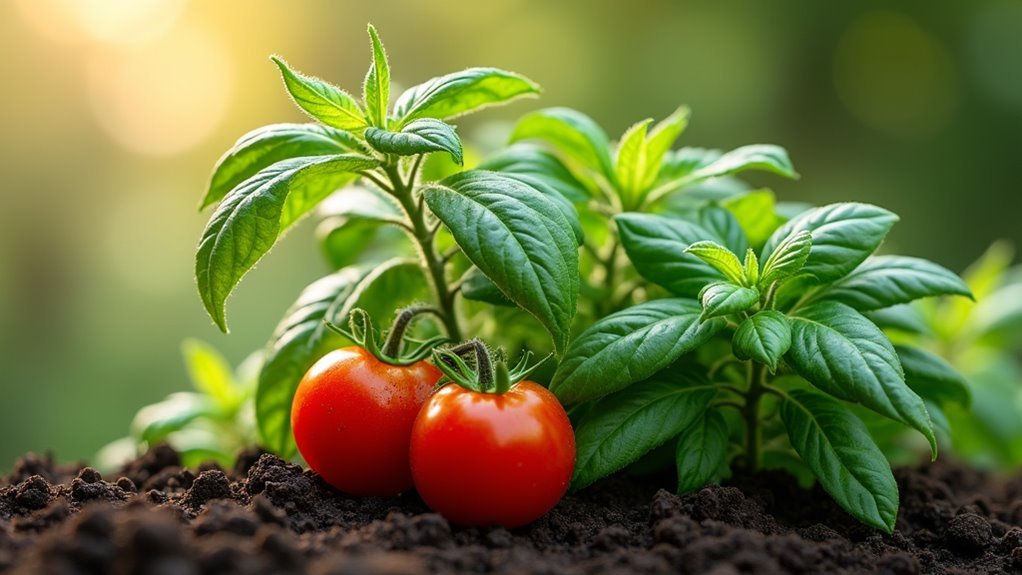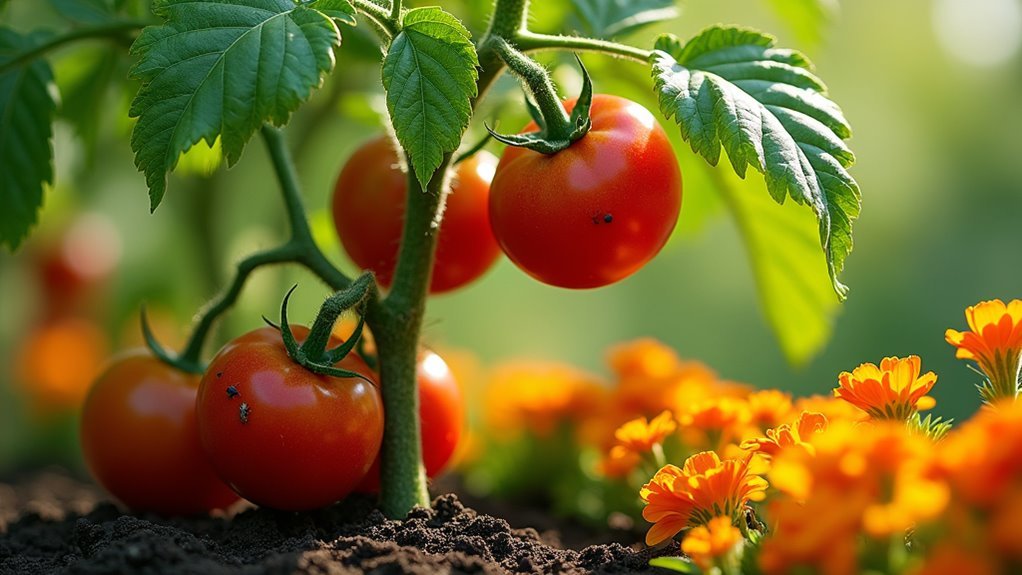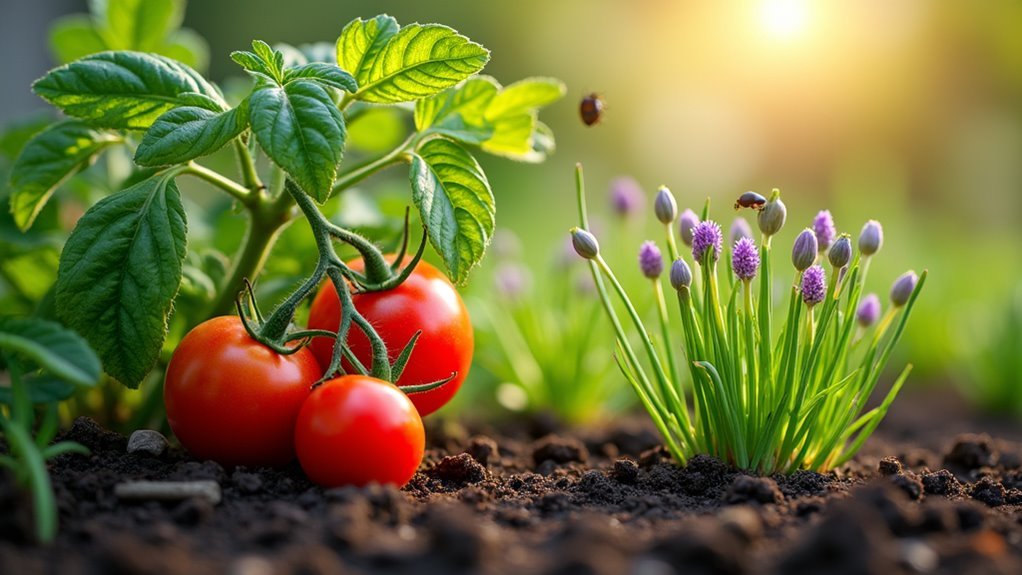You can protect your tomato plants by strategically planting seven key companions that naturally repel pests. Basil masks tomato aromas to deter hornworms, while marigolds release root compounds that eliminate nematodes. Nasturtiums act as trap crops for aphids, and garlic’s pungent scent creates barriers against spider mites. Chives repel Japanese beetles, borage deters hornworms, and thyme serves as living mulch against armyworms. These partnerships’ll create a balanced ecosystem that enhances your garden’s natural defenses.
Basil: Natural Repellent for Tomato Hornworms and Thrips

When you’re battling tomato hornworms and thrips in your garden, basil serves as one of nature’s most effective deterrents. This aromatic herb’s strong scent masks your tomato plants’ natural aroma, making them less attractive to these destructive pests.
As an ideal companion plant for tomatoes, basil doesn’t just repel aphids and other harmful insects—it actively attracts beneficial insects that enhance pollination and natural pest control.
You’ll discover that basil’s protective qualities extend beyond pest management. Growing this culinary herb alongside your tomatoes can greatly improve the flavor of your harvest while boosting overall yields.
Since basil thrives in similar conditions as tomatoes, you can easily integrate it into your existing garden space for maximum protection and enhanced plant health.
Marigolds: Guardian Plants Against Nematodes and Garden Pests
While many gardeners struggle with soil-dwelling nematodes that attack tomato roots, marigolds offer a powerful underground defense system.
These vibrant flowers release toxic substances from their roots that eliminate harmful nematodes naturally, protecting your tomato plants from below-ground damage.
Above ground, marigolds repel garden pests through their strong scent, deterring destructive tomato hornworms that can devastate your crop.
You’ll find these guardian plants work double duty by attracting beneficial insects that pollinate your tomatoes while keeping harmful pests away.
Intersperse marigolds throughout your tomato garden for maximum protection.
They’re remarkably easy to grow and thrive in zones 2-11, making them accessible companions regardless of your climate.
You’ll enhance your tomato plants’ health while adding beautiful color to your garden space.
Nasturtiums: Trap Crops That Lure Aphids Away From Tomatoes

You’ll find nasturtiums work as excellent trap crops because their sweet stem sap attracts aphids more effectively than tomato plants do.
When you plant nasturtiums strategically around your tomato garden, they’ll lure these pests away from your valuable crop.
You can maximize this protection by interspersing nasturtiums within tomato rows or creating protective borders around your garden’s perimeter.
Aphid Attraction Mechanism
Since aphids possess an irresistible attraction to the sweet, nutrient-rich sap found in nasturtium stems, these colorful flowers function as highly effective trap crops in your garden.
When you strategically plant nasturtiums near your tomato plants, the aphids naturally gravitate toward the more appealing nasturtium sap instead of attacking your valuable tomato crops.
This companion plants for tomatoes strategy works because nasturtiums fundamentally act as decoys, concentrating pest populations away from your main harvest.
The concentrated aphid presence on nasturtiums creates an efficient pest control system while simultaneously attracting beneficial insects that prey on these pests.
You’ll discover that this natural trap crop method protects your tomatoes without requiring harmful chemical interventions.
Strategic Garden Placement
Positioning nasturtiums correctly around your tomato plants maximizes their effectiveness as trap crops and creates the strongest possible pest deterrent barrier.
You’ll want to establish nasturtium borders around your tomato patches or intersperse them throughout your growing area. This companion planting strategy guarantees aphids encounter the more attractive nasturtiums before reaching your tomatoes.
When you plant tomatoes, consider spacing nasturtiums every few feet to maintain consistent coverage. Many gardeners believe placing these plants to grow along garden perimeters works best, though scattered placement within beds also proves effective.
While nasturtiums primarily serve as sacrificial plants rather than directly repel pests, they’ll still attract beneficial insects that help control other garden problems, creating a more balanced ecosystem around your tomato plants.
Garlic: Powerful Deterrent for Spider Mites and Soil Pests
Garlic’s pungent aroma works as nature’s security system for your tomato garden, creating an invisible barrier that deters destructive pests before they can establish themselves.
Garlic’s natural fragrance acts as an invisible shield, deterring garden pests before they can damage your precious tomato plants.
When planting tomatoes alongside garlic, you’ll notice fewer spider mites attacking your plants. These microscopic pests cause significant leaf damage, but garlic’s strong scent repels them effectively. You can maximize pest control benefits by using garlic as both a companion plant and foliar spray to reduce disease like late blight.
Garlic targets soil pests too, protecting your tomato roots from underground threats.
Beyond pest management, this partnership will enhance the flavor of your tomatoes through beneficial plant interactions. Since garlic requires minimal space, you’ll optimize garden efficiency while creating a natural defense system.
Chives: Aromatic Defense Against Japanese Beetles and Aphids

With their distinctive onion-like fragrance, chives create a powerful aromatic shield that drives away Japanese beetles and aphids from your tomato plants.
You’ll find these hardy herbs exceptionally effective at pest control when planted directly at the base of your tomatoes, forming a natural barrier against harmful insects.
Chives thrive in well-drained soil and full sun conditions, making them ideal companion plants that’ll maximize their strong scent’s pest-repelling properties.
You can easily grow them in various garden environments while enjoying the dual benefits of protection and culinary use.
Borage: Effective Protection From Tomato Hornworms
You’ll find borage’s natural compounds create an effective barrier against destructive tomato hornworms while simultaneously attracting beneficial pollinators to your garden.
The plant’s beautiful blue flowers don’t just repel pests—they’ll also draw bees and other helpful insects that boost your tomato yields.
As an added bonus, you can harvest borage’s edible flowers and leaves for culinary use, making this companion plant both protective and productive.
Natural Hornworm Deterrent Properties
Although tomato hornworms can devastate your entire crop within days, borage serves as one of nature’s most effective deterrents against these voracious pests. When you plant borage near your tomatoes, this Tomato Companion releases a distinctive scent that hornworms find repulsive, creating an invisible barrier around your precious plants.
Beyond its repellent properties, borage will attract beneficial insects like predatory wasps and pollinators to your vegetable garden. These natural allies help control late-season pest populations while eliminating harmful bugs that threaten your harvest. This strategic partnership greatly enhances your gardening experience by reducing the need for chemical interventions.
The aromatic compounds borage emits work continuously, providing round-the-clock protection.
You’ll discover that this natural approach not only safeguards your tomatoes but also promotes a healthier, more balanced garden ecosystem.
Pollinator Attraction Benefits
When borage blooms throughout the growing season, its star-shaped blue flowers become a magnet for bees, butterflies, and other essential pollinators that your tomato plants desperately need. This pollinator attraction creates a thriving garden ecosystem where beneficial insects naturally control pest populations while boosting tomato productivity.
| Pollinator Type | Garden Benefit |
|---|---|
| Bees | Enhanced tomato fruit set |
| Butterflies | Cross-pollination support |
| Hoverflies | Aphid population control |
| Parasitic wasps | Hornworm egg destruction |
The fragrant nectar from borage flowers specifically draws insects that repel pests while supporting your tomatoes’ reproductive success. You’ll notice increased yields and healthier plants when these beneficial insects establish residence in your garden. Borage’s dual action of attracting helpful pollinators and deterring harmful pests makes it an invaluable companion plant for maximizing your tomato harvest.
Edible Flower Harvest
Beyond borage’s remarkable pest-deterrent properties, its delicate blue flowers offer a delightful culinary bonus that transforms your garden into both a protective barrier and a gourmet ingredient source.
You’ll discover these edible flowers provide a cucumber-like flavor that enhances salads and garnishes while simultaneously protecting your tomatoes from hornworms.
Your borage plants serve dual purposes as companion plants, creating natural ground cover that suppresses weeds while deterring pests and diseases.
The vibrant blooms consistently attract bees and other pollinators, ensuring beneficial insects remain active in your garden ecosystem.
You can harvest these flowers throughout the growing season, enjoying fresh edible flower harvest while maintaining the plant’s protective qualities.
This strategic planting approach maximizes both your garden’s productivity and culinary potential.
Thyme: Living Mulch That Reduces Armyworm Damage
While most gardeners think of mulch as wood chips or straw, thyme offers a fragrant, living alternative that actively protects your tomato plants from destructive pests.
This aromatic herb creates an effective living mulch around your tomatoes, suppressing weeds while retaining essential soil moisture. Thyme’s aromatic nature considerably reduces yellow striped armyworm egg-laying rates, providing excellent pest control without chemicals.
You’ll also attract beneficial insects to your garden ecosystem, creating a natural defense system that enhances overall protection.
Since thyme’s a perennial, you’ll need to plan its placement carefully for long-term benefits. As an added bonus, you can harvest this versatile herb for cooking, making it perfect for tomato-based dishes while maintaining your garden’s functionality and beauty.
Frequently Asked Questions
What Do You Plant Next to Tomatoes to Keep the Bugs Away?
You’ll want to plant basil, marigolds, nasturtiums, garlic, and chives alongside your tomatoes. These companions repel various pests like aphids, hornworms, thrips, and spider mites while enhancing your garden’s natural defenses.
What Is the Best Companion Plant for Tomatoes?
You’ll find basil’s the best companion plant for your tomatoes. It enhances their growth, improves flavor, and repels harmful pests like thrips and tomato hornworms with its natural properties and aromatic oils.
What Deters Pests From Tomatoes?
You’ll deter pests from tomatoes by planting basil, marigolds, nasturtiums, garlic, chives, and dill nearby. These companions repel harmful insects through strong scents, trap crops, and attracting beneficial predators that naturally control pest populations.
What Is the Best Thing to Put Around Tomato Plants?
You’ll want to plant basil directly around your tomato plants since it repels hornworms and thrips while enhancing flavor. Marigolds and nasturtiums also work excellently as protective companions that deter various pests.
In Summary
You’ll transform your tomato garden into a pest-resistant fortress by strategically planting these seven companion plants. You’re creating a natural defense system that doesn’t rely on harmful chemicals. You’ll notice fewer pest problems and healthier tomato plants when you incorporate basil, marigolds, nasturtiums, garlic, chives, borage, and thyme into your garden design. Start companion planting this season and you’ll enjoy more bountiful, pest-free tomato harvests while supporting beneficial insects.





Leave a Reply